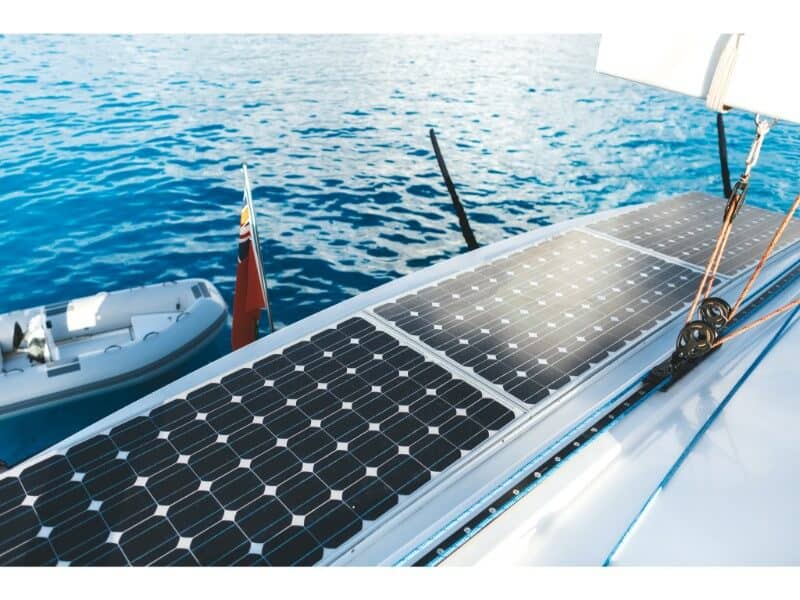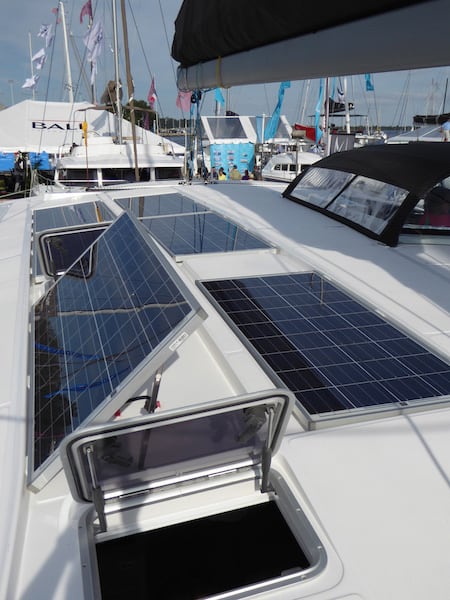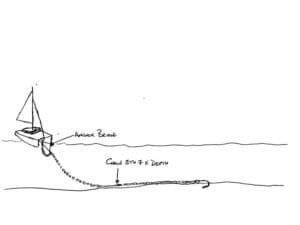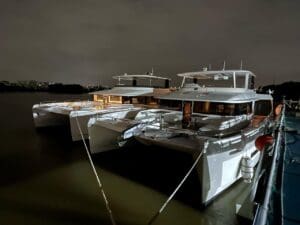
Catamaran solar panels come in all sizes and shapes for use in many areas of boats to generate extra energy. With today’s modern multihulls and all their amenities like electric winches, full-size American fridges, watermakers, and our love of energy-sucking kitchen gadgets, planning for all your energy needs is a vital plan, especially if you are ocean-going or liveaboard.
Solar panels make it easier to meet those demands.
Solar panels convert the sun’s incoming radiation (light) directly into electricity, which can be used to charge batteries and operate DC loads. It’s becoming more popular among sailors not only because they can keep lights and appliances running, but also because they are quieter than wind generators (and, of course, diesel generators). The source of energy replenishment is also free and abundant (after initial investment). We have had solar panels on our cruising catamarans that we have owned and thus have first-hand experience at how wonderful a source of supplemental energy aboard can be.
Solar Panels Add Convenience to Sailing
On our Island Spirit catamaran years ago, we had solar panels and a wind generator. We found we could easily have done without the wind generator to serve our daily amp needs. The wind generator was noisy and, because it had moving parts, it required maintenance.
The advantage with the wind generator is that it works 24 hours a day versus the solar which only charges the batteries when the sun is shining. While underway, it is nice to have the additional power from the wind generator, but for some, it may not outweigh the annoyance of constant noise especially at anchor.
Modern electronics such as auto pilots and LED lights have become very energy efficient, which means that the battery drain is not as great as they once were. But we all have become used to more conveniences like watermakers and big fridges.

Solar panels can easily keep up with the demand, especially when combined with an hour of engine generation per day or other power accommodations.
Our Lagoon 450S, Zuri, had no wind generator and two 230W solar panels with an additional house battery. We found that this setup worked well as liveaboards whether sailing offshore or cruising locally. In my opinion, the more energy generation we can fit on the boat that is in solid state and requires no maintenance, the better. Our Bali 5.4, Z3, that we sailed in the ARC Rally soon after taking possession of her had a hydrogenerator which we highly recommend especially for ocean crossings. Check out our tips on energy management aboard your boat for the pros and cons of solar panels, wind turbines, hydrogenerators, and more.
There are many reasons to consider using solar energy for your yacht:
- Yachts with no access to shore power need to keep batteries topped off.
- Cruising yachts to augment charging options.
- Boats without auxiliary engines may use solar power for all onboard uses.
What to Look for in Catamaran Solar Panels

When selecting solar panels for your boat, there are several important questions you should ask yourself:
- Is it necessary for the panel to be flexible? The thin film panels are the only ones that flex more than a little. They can be mounted on curved surfaces like a dodger.
- What is the cost per watt of output of the panel? Large hard panels generally have the greatest output per dollar.
- Are you limited in the area available for solar panel coverage? The highest efficiency panels are the monocrystalline type.
- Will it be difficult to protect the panel from partial shading during the day? Thin film panels are more tolerant of shading.
- Will the panel be used in high temperatures? If so, consider a higher voltage panel, or a thin film.
- How much energy will you need? Match your marine electrical needs to the right size of panels and batteries.
Estimate Your Boat's Energy Usage
The first step in answering these questions is to estimate your vessel’s energy usage. It takes some time but is easier than you think.
Download our Vessel Energy Estimator spreadsheet to help you create a comprehensive assessment of the draw of current for each piece of equipment (tip: confirm with a panel ammeter to increase accuracy) and the number of hours you estimate tor that you operate each appliance daily.
SUBMIT THE FORM BELOW TO GET THE ESTIMATOR SPREADSHEET EMAILED TO YOU
Estimate Battery Storage
Once you understand the energy demands of your vessel and its crew, estimate the battery storage capacity you will need.
Write down the number and capacity of your batteries. Keep in mind that drawing below 50% charge will shorten their life, and that when away from the dock, you will rarely charge past 85%. This means that you should plan for using only 35% of your battery configuration’s nameplate capacity.
Determine Your Boat's Solar Energy Needs
Keep in mind that you may other charging sources in addition to the solar you are planning to upgrade or add: engine, wind, hydrogenerator, and solar. So total the energy produced by all your energy generation sources.
Note for your solar estimate, use the rated wattage x 5 hours/12 = amp-hours while on passage and wattage x 7 hours/12 = amp-hours while at anchor (sails do not shade and the boom can be rigged out to the side). This is below the rated capacity and keep in mind that sailing in the tropics will produce more than higher latitudes. And sailing in the winter will produce less from solar.
Fine-Tune Your Solar Panel Output Estimate
Keep in mind how external factors will affect solar power generation:
- Full sun with panel square to the sun: 100%
- Full sun with panel at 45° angle to sun: 71%
- Light cloudy overcast: 20-70%
- Heavy overcast: 10-20%
Determine how you will use the solar energy combined other energy sources by answering these questions:
- How many days can you manage with lower solar energy generation?
- Are you and your crew willing to cut back on non-necessity use during extended inclement weather?
- Will you periodically recharge by running the engine or at dock?
- Are you living aboard or a long-term cruiser who will value more abundant power or are you an occasional cruiser who may be fine living with less power availability? See our tips below for saving energy aboard a boat.
Tips on Saving Power while Aboard
Every amp-hour (AH) you use requires a trade-off in weight of and investment in solar panels or other power generation equipment. If you run your engine for power, you have higher maintenance costs such as oil changes (and noisy, stinky smell, as well as higher environmental impact).
Reducing power consumption by 50 AH/day can reduce your need to add a battery, a 120-watt solar panel, and other accessories such as a mounting arch. The solar power system savings could be $500 and 150 pounds of carrying weight for small power consumption compromises.
Here are some ideas for where you can almost painlessly cut power usage:
Lighting. Swap out all incandescent and halogen bulbs to LED or fluorescent lighting. To space out investment, especially for pricier LED bulbs, start with lights you use most often. Consider starting with the anchor, saloon, and cockpit lights. If you rarely run at night, you can postpone changing out the running, steaming lights, deck light, and some task lights.
Change Your Bedtime. Go to bed early and rise with the sun to give yourself a large savings in power consumption and and more play time.
Gas Solenoid. If you use a gas solenoid to run appliances like your propane fridge and cabin heater, it is running for long periods. Consider turning it off at night. Also, consider if you can go without refrigeration sometimes.
Refrigeration. Chill provisions before bringing them aboard, if possible. Deep chill your fridge and freezer at lower temperature ranges using shore power at least 24 hours before leaving the dock. Then set your temperatures higher while cruising. Invest in high-efficiency refrigeration units and consider that top-entry fridges/freezers are usually more efficient. Regularly check your refrigeration unit doors and lids for good seal and promptly replace old or compromised gaskets.
Refrigeration Planning. Using your refrigeration appliances efficiently with good habits can significantly reduce energy consumption. Organize your food when you provision, arranging it in the order you plan to use it and in such a way that you don’t have to hold the door open for extending periods of time looking for something. Using dividers and creating foam compartments to arrange food by temperature can be helpful as they reduce the amount of cold air that escapes when open the unit.
Watermaker. In addition to refrigeration, watermakers can be your biggest energy consumer even with today’s higher efficiency models. Avoid draining your batteries or running engines or the generator by running the watermaker while you’re motoring or when it is sunniest (or windiest if you also use wind generation). And, of course, use water sparingly.
Air Circulation. Run fans on low speed and watch the hours. A wind scoop does not consume power.
Instruments. Consider turning off some power-hungry instruments such as your GPS or radar for parts of your passage. Minimize the autopilot load by balancing the sails. Use an energy-efficient computer with Energy Star certification and a solid state drive as everyday tasks such as checking grib files or blogging can be astonishingly energy hogging.






